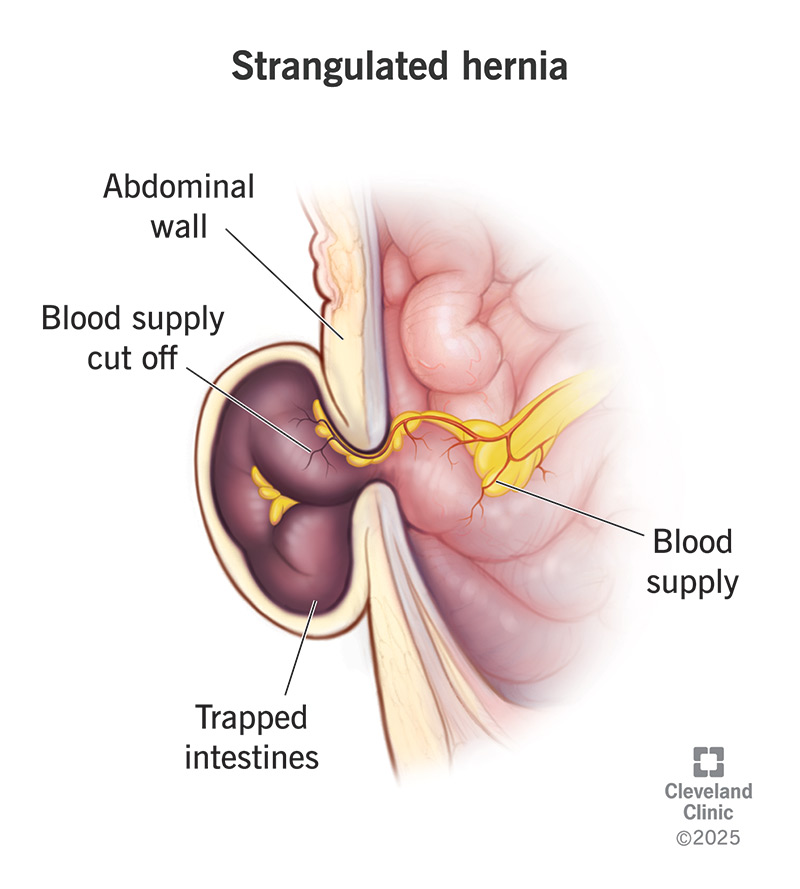Strangulated Hernia: A Comprehensive Guide to Symptoms, Risks, and Emergency Treatment

Key points
- Sudden, severe, and rapidly worsening pain at the hernia site or in the abdomen.
- A hernia bulge that becomes firm, tender, and cannot be pushed back in.
- Red, purple, or dark discoloration of the skin over the hernia.
- Nausea and vomiting.
- Fever.
- Inability to pass gas or have a bowel movement (a sign of bowel obstruction).
A hernia might start as a small, painless bulge, but it holds the potential to become a life-threatening medical emergency. When a hernia becomes strangulated, it's a race against time where immediate medical intervention is critical. Understanding the signs, risks, and the necessity for urgent treatment can be the difference between a full recovery and devastating complications.
This comprehensive guide synthesizes information from leading medical institutions and patient experiences to provide a complete picture of what a strangulated hernia is, how to recognize it, and what to expect from treatment.
What is a Strangulated Hernia?
A strangulated hernia is the most severe complication of a hernia. It occurs when a section of tissue, often part of the intestine or abdominal fat, pushes through a weak spot in the abdominal wall and becomes so tightly trapped that its blood supply is completely cut off.
According to the Cleveland Clinic, this lack of blood flow causes the tissue to be starved of oxygen, leading to cell death (necrosis) and potentially gangrene within hours. This is not just a worsening of hernia pain; it is a surgical emergency that can prove fatal if left untreated.
 Source: Cleveland Clinic
Source: Cleveland Clinic
The Progression: From Reducible to Strangulated
A hernia doesn't typically become strangulated overnight. It follows a dangerous progression:
- Reducible Hernia: An early-stage hernia where the protruding bulge can be gently pushed back into the abdomen. It may cause discomfort but is not an immediate danger.
- Incarcerated (or Irreducible) Hernia: The herniated tissue becomes trapped in the abdominal wall and cannot be pushed back in. As Healthline clarifies, an incarcerated hernia can lead to a bowel obstruction and is a precursor to strangulation, but it is not yet life-threatening on its own.
- Strangulated Hernia: The pressure from the surrounding muscle on the incarcerated tissue becomes so intense that it cuts off the blood flow. This is the critical stage where tissue begins to die, releasing toxins into the bloodstream and setting the stage for severe infection and sepsis.
The timeline from incarceration to strangulation and necrosis can be alarmingly short. Tissue can become gangrenous within hours, highlighting the need for immediate action.
Recognizing the Warning Signs: Symptoms of a Strangulated Hernia
It is crucial to distinguish the discomfort of a simple hernia from the severe symptoms of a strangulated one. If you have a known hernia and experience the following, seek emergency medical help immediately.
According to experts at the Mayo Clinic and Johns Hopkins Medicine, the key warning signs include:
- Sudden, severe, and rapidly worsening pain at the hernia site or in the abdomen.
- A hernia bulge that becomes firm, tender, and cannot be pushed back in.
- Red, purple, or dark discoloration of the skin over the hernia.
- Nausea and vomiting.
- Fever.
- Inability to pass gas or have a bowel movement (a sign of bowel obstruction).
- A rapid heart rate.
- Bloating or a full, round abdomen.
When to Go to the ER: If you have a hernia and develop any of the symptoms listed above, do not wait. Go to the nearest emergency room or call for an ambulance immediately. This is a life-threatening condition.
Risk Stratification: Who Is Most at Risk?
While any hernia can theoretically become strangulated, certain hernia types and patient factors carry a significantly higher risk.
High-Risk Hernia Types
- Femoral Hernias: Occurring in the upper thigh/groin, these have the highest risk of strangulation due to the narrow and rigid nature of the femoral canal where they protrude.
- Indirect Inguinal Hernias: These are more likely to strangulate than direct inguinal hernias.
- Hernias with Small Defects: Counterintuitively, hernias pushing through a smaller, tighter opening in the muscle are more likely to become trapped and have their blood supply constricted.
High-Risk Patient Profiles
- Patients with Irreducible Hernias: An inability to push the hernia back in is the most significant warning sign.
- Individuals with Worsening Symptoms: Increasing pain, even without other signs, should prompt a visit to the doctor.
- Factors Increasing Abdominal Pressure: Conditions like a chronic cough, straining during bowel movements, pregnancy, and strenuous heavy lifting can force tissue into the hernia sac and increase the risk of entrapment.
Diagnosis and Immediate Medical Response
A strangulated hernia is typically diagnosed in an emergency room based on a physical examination and a review of the patient's severe symptoms. A doctor can often identify it by the firm, tender, and discolored bulge.
To confirm the diagnosis and assess the extent of the damage, imaging tests are often used:
- Abdominal Ultrasound or CT Scan: These tests can show the trapped tissue, check for signs of bowel obstruction, and confirm the lack of blood flow.
Once diagnosed, the only course of action is immediate surgery.
!Medical professionals reviewing a CT scan
Treatment: Emergency Surgery is Essential
Surgery is the only treatment for a strangulated hernia and must be performed as soon as possible. The primary goals of the operation are to release the trapped tissue, restore blood flow, and repair the hernia defect.
The surgical procedure typically involves:
- Making an incision over the hernia. Open surgery is often preferred in emergencies to allow the surgeon a clear view.
- Releasing the trapped tissue (reducing the hernia).
- Assessing tissue viability. The surgeon carefully inspects the tissue to see if it is still alive. If blood flow returns and the tissue appears healthy, it is returned to the abdominal cavity.
- Bowel Resection. If the tissue (often a part of the intestine) is necrotic or dead, that section must be surgically removed, and the healthy ends of the intestine are reconnected.
- Hernia Repair. The weakened area in the abdominal wall is repaired, often using stitches or a synthetic mesh to reinforce the area and prevent recurrence.
A complex case published by the American College of Surgeons details a multi-stage, multidisciplinary approach involving both abdominal and thoracic surgeons to save a patient with a severely strangulated hiatal hernia, underscoring the gravity and complexity of these emergencies.
Recovery, Prognosis, and Long-Term Outlook
The prognosis after surgery for a strangulated hernia depends almost entirely on how quickly the patient received treatment.
Prognosis and Mortality Rates
When a hernia strangulates, the outlook becomes much more serious. A large Swedish study highlighted by The British Hernia Centre found that:
- The risk of death after an emergency hernia operation is 7 times higher than for a planned, elective repair.
- If a bowel resection is required due to dead tissue, the mortality risk is 20 times higher.
Delayed treatment is the most significant factor in poor outcomes. The presence of bowel necrosis dramatically worsens the prognosis and increases the risk of post-operative complications like severe infection (peritonitis), sepsis, and shock.
The Recovery Process and Long-Term Quality of Life
Recovery from emergency surgery is more involved than from an elective procedure. A hospital stay of several days is usually required, and patients may need antibiotics for infection. Full recovery can take several weeks, with restrictions on strenuous activity and heavy lifting.
Long-term complications can include:
- Chronic Pain: A small percentage of patients experience chronic pain at the surgical site.
- Hernia Recurrence: There is a risk that the hernia can return.
- Mesh Complications: In rare cases, issues can arise with the surgical mesh used in the repair.
Despite these risks, most patients who receive timely treatment go on to live a full and healthy life.
The Dangers of Delay: What Happens if Left Untreated?
Ignoring a hernia can have devastating consequences, as one patient shared in a harrowing account on Health.com. After ignoring her doctor's advice for years, she experienced excruciating pain that she initially mistook for a stomach bug. By the time she reached the hospital, she had a strangulated hernia and a severe infection in her colon. Her doctors told her that waiting another 24 hours could have been fatal.
This experience highlights a critical truth: hernias do not go away on their own. The "watch and wait" approach is only safe under a doctor's supervision and for hernias that are asymptomatic and at low risk of complications. An untreated strangulated hernia will lead to:
- Gangrene of the trapped intestine.
- Perforation (a hole) in the bowel wall.
- Peritonitis, a severe infection of the abdominal lining.
- Sepsis, a body-wide, life-threatening reaction to infection.
- Death.
Frequently Asked Questions (FAQ)
What is a strangulated hernia?
A strangulated hernia is a life-threatening medical emergency that occurs when the blood supply to tissue trapped in a hernia (often a part of the intestine) is cut off by the surrounding muscle. This lack of blood flow leads to tissue death (necrosis), which can cause severe complications like gangrene, sepsis, and bowel perforation if not treated with immediate surgery.
How can you tell if your hernia is strangulated?
Key signs of a strangulated hernia include: sudden, severe, and worsening pain at the hernia site; a bulge that is firm, tender, and cannot be pushed back in; redness, purple, or dark discoloration of the skin over the hernia; nausea and vomiting; fever; bloating and an inability to pass gas or have a bowel movement; and a rapid heart rate. If you experience these symptoms, seek emergency medical care immediately.
What happens if a hernia bursts or ruptures?
A hernia 'bursting' or rupturing is a rare but catastrophic medical emergency. It means the weakened muscle tissue has torn completely, allowing the hernia's contents (like the intestine) to spill into the body cavity. This can lead to severe internal bleeding, widespread infection (peritonitis), and tissue death. It requires immediate emergency surgery, which is often more complex and has a longer recovery than a planned hernia repair.
How long can you live with an untreated hernia?
While a person can live for months or even years with a small, asymptomatic hernia, it is not recommended to leave it untreated. Hernias do not heal on their own and tend to worsen over time. The primary danger is the risk of it becoming incarcerated (trapped) and then strangulated, which is a life-threatening emergency that can develop suddenly.
References
- Cleveland Clinic. (2025). Strangulated Hernia: Signs & Symptoms, Treatment.
- Healthline. (2017). Strangulated Hernia: Symptoms, Treatment, Outlook, and More.
- The British Hernia Centre. Strangulated Hernia.
- Mayo Clinic. Inguinal hernia - Symptoms & causes.
- Health.com. (2023). Here's What To Do (And Not To) if You Have an Untreated Hernia.
- American College of Surgeons. (2025). A Catastrophic Complication: Strangulated Hiatal Hernia....

About the author
Michael O'Connell, DO, is a board-certified emergency medicine physician working as an attending physician at a busy Level I Trauma Center in Philadelphia, Pennsylvania. He also serves as a clinical instructor for medical residents and is active in wilderness medicine.